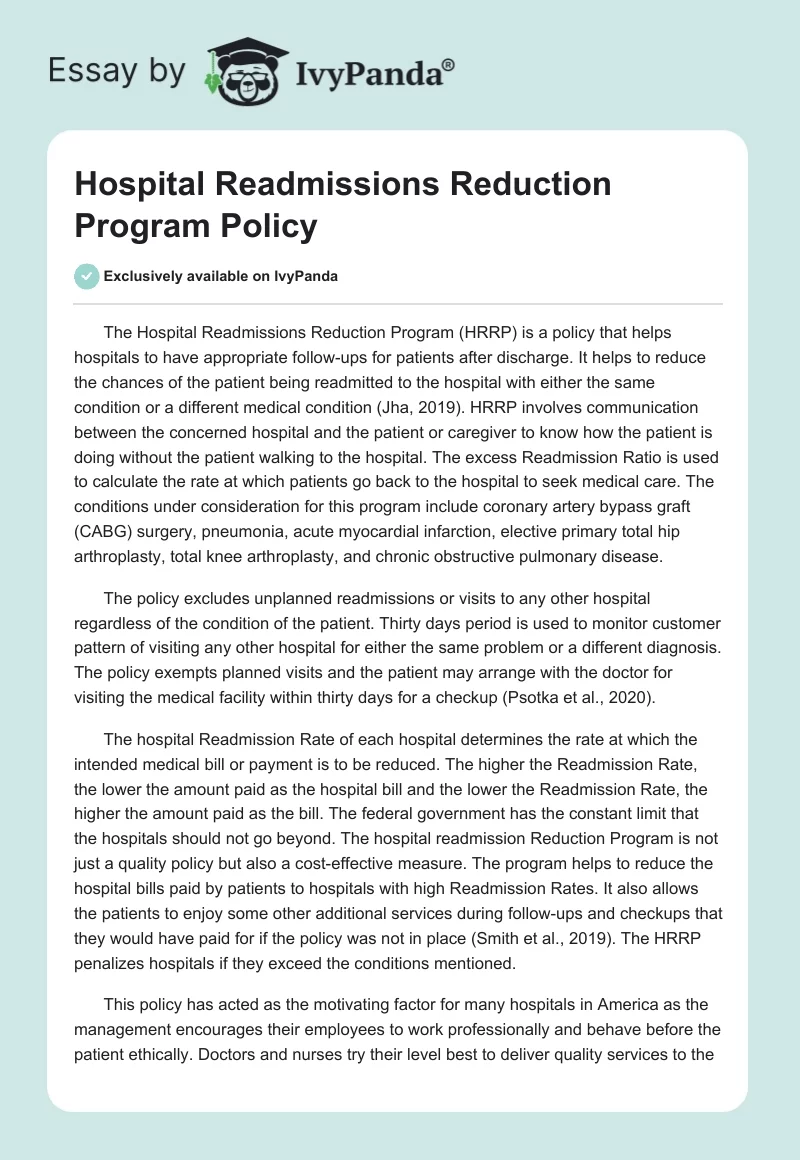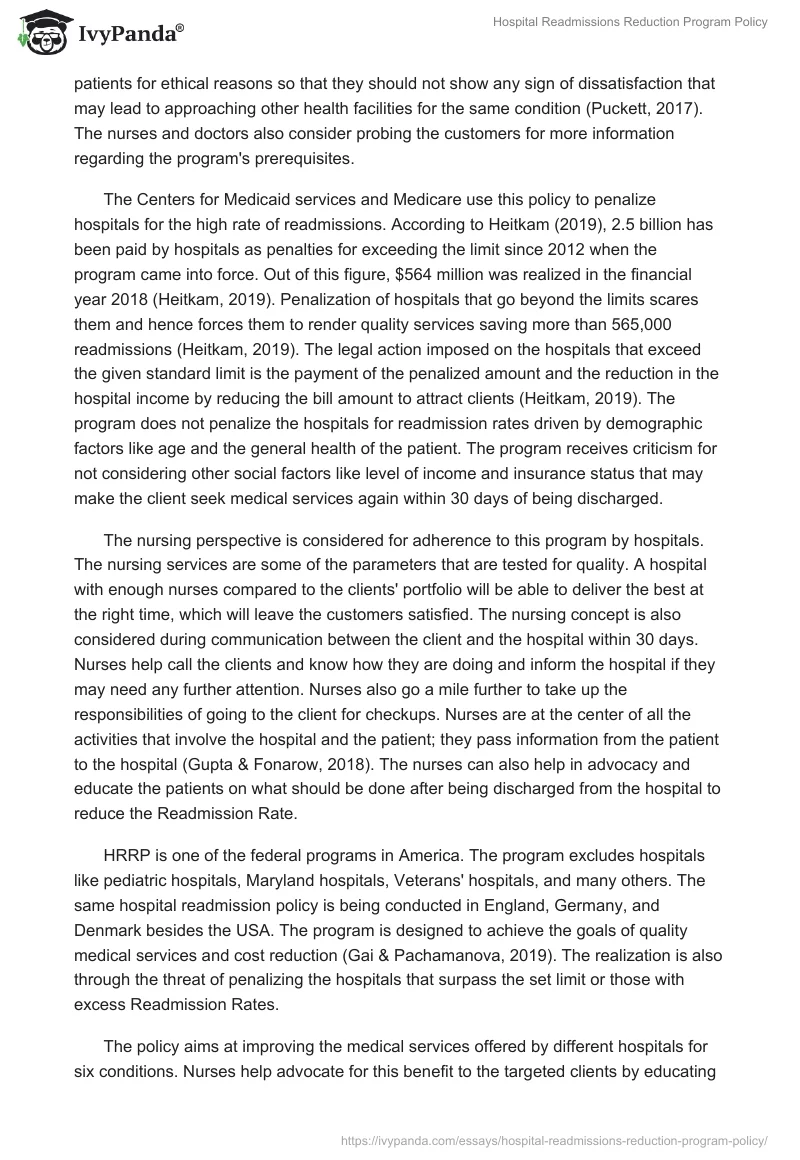The Hospital Readmissions Reduction Program (HRRP) is a policy that helps hospitals to have appropriate follow-ups for patients after discharge. It helps to reduce the chances of the patient being readmitted to the hospital with either the same condition or a different medical condition (Jha, 2019). HRRP involves communication between the concerned hospital and the patient or caregiver to know how the patient is doing without the patient walking to the hospital. The excess Readmission Ratio is used to calculate the rate at which patients go back to the hospital to seek medical care. The conditions under consideration for this program include coronary artery bypass graft (CABG) surgery, pneumonia, acute myocardial infarction, elective primary total hip arthroplasty, total knee arthroplasty, and chronic obstructive pulmonary disease.
The policy excludes unplanned readmissions or visits to any other hospital regardless of the condition of the patient. Thirty days period is used to monitor customer pattern of visiting any other hospital for either the same problem or a different diagnosis. The policy exempts planned visits and the patient may arrange with the doctor for visiting the medical facility within thirty days for a checkup (Psotka et al., 2020).
The hospital Readmission Rate of each hospital determines the rate at which the intended medical bill or payment is to be reduced. The higher the Readmission Rate, the lower the amount paid as the hospital bill and the lower the Readmission Rate, the higher the amount paid as the bill. The federal government has the constant limit that the hospitals should not go beyond. The hospital readmission Reduction Program is not just a quality policy but also a cost-effective measure. The program helps to reduce the hospital bills paid by patients to hospitals with high Readmission Rates. It also allows the patients to enjoy some other additional services during follow-ups and checkups that they would have paid for if the policy was not in place (Smith et al., 2019). The HRRP penalizes hospitals if they exceed the conditions mentioned.
This policy has acted as the motivating factor for many hospitals in America as the management encourages their employees to work professionally and behave before the patient ethically. Doctors and nurses try their level best to deliver quality services to the patients for ethical reasons so that they should not show any sign of dissatisfaction that may lead to approaching other health facilities for the same condition (Puckett, 2017). The nurses and doctors also consider probing the customers for more information regarding the program’s prerequisites.
The Centers for Medicaid services and Medicare use this policy to penalize hospitals for the high rate of readmissions. According to Heitkam (2019), 2.5 billion has been paid by hospitals as penalties for exceeding the limit since 2012 when the program came into force. Out of this figure, $564 million was realized in the financial year 2018 (Heitkam, 2019). Penalization of hospitals that go beyond the limits scares them and hence forces them to render quality services saving more than 565,000 readmissions (Heitkam, 2019). The legal action imposed on the hospitals that exceed the given standard limit is the payment of the penalized amount and the reduction in the hospital income by reducing the bill amount to attract clients (Heitkam, 2019). The program does not penalize the hospitals for readmission rates driven by demographic factors like age and the general health of the patient. The program receives criticism for not considering other social factors like level of income and insurance status that may make the client seek medical services again within 30 days of being discharged.
The nursing perspective is considered for adherence to this program by hospitals. The nursing services are some of the parameters that are tested for quality. A hospital with enough nurses compared to the clients’ portfolio will be able to deliver the best at the right time, which will leave the customers satisfied. The nursing concept is also considered during communication between the client and the hospital within 30 days. Nurses help call the clients and know how they are doing and inform the hospital if they may need any further attention. Nurses also go a mile further to take up the responsibilities of going to the client for checkups. Nurses are at the center of all the activities that involve the hospital and the patient; they pass information from the patient to the hospital (Gupta & Fonarow, 2018). The nurses can also help in advocacy and educate the patients on what should be done after being discharged from the hospital to reduce the Readmission Rate.
HRRP is one of the federal programs in America. The program excludes hospitals like pediatric hospitals, Maryland hospitals, Veterans’ hospitals, and many others. The same hospital readmission policy is being conducted in England, Germany, and Denmark besides the USA. The program is designed to achieve the goals of quality medical services and cost reduction (Gai & Pachamanova, 2019). The realization is also through the threat of penalizing the hospitals that surpass the set limit or those with excess Readmission Rates.
The policy aims at improving the medical services offered by different hospitals for six conditions. Nurses help advocate for this benefit to the targeted clients by educating them when they are being discharged or sensitizing them to report any recurring health condition among six conditions that may make the patient be readmitted. Discharged patients are educated on the importance of periodic and planned checkups within 30 days. Sensitization might also be advocated by the federal government effectively. The federal government may train the hospital management on how to reduce the Readmission Rate. In return, the management trains the nurses and the doctors on how to offer quality services to their clients (Arifoglu et al., 2018). This will help the concerned hospital not to be penalized for higher Readmission Rates and increase the income of the hospital.
From the Christian perspective of advocacy, the good Samaritan story sets an excellent example of how nurses and doctors should treat patients regardless of their social status. Nurses should be on the frontline to care for the poor and champion justice for the oppressed by offering equitable medical services to all patients without considering their backgrounds. Poor people should be sensitized so that they should enjoy the program’s benefit by being given the correct information about what it entails (Carey & Lin, 2016). If the patient is not well treated, the hospital should take responsibility and serve the customer with justice, hence reducing the chances of the customer being readmitted to a different hospital either with the same condition or with another condition.
References
Arifoglu, K., Ren, H., & Tezcan, T. (2018). Hospital Readmissions Reduction Program does not provide the right incentives: Issues and remedies. SSRN Electronic Journal. Web.
Binder, W. J., & Cook, J. L. (2017). A perspective on recent hospital strategies to reduce heart failure readmissions and improve outcomes. Current Cardiovascular Risk Reports, 11 (33), 165-169. Web.
Carey, K., & Lin, M. (2016). Hospital Readmissions Reduction Program: Safety-net hospitals show improvement, but modifications to the penalty formula are still needed. Health Affairs, 35(10), 1918-1923. Web.
Gai, Y., & Pachamanova, D. (2019). Impact of the Medicare Hospital Readmissions Reduction Program on vulnerable populations. BMC Health Services Research, 19(1), 111-116. Web.
Gupta, A., & Fonarow, G. C. (2018). The hospital readmissions reduction program-learning from the failure of a healthcare policy. European Journal of Heart Failure, 20(8), 1169-1174. Web.
Heitkam, R. (2019). Reducing hospital readmissions through faith community nursing. Nursing Management, 50(8), 26-30. Web.
Jha, A. K. (2019). What do readmission rates in Canada tell us about the Hospital Readmissions Reduction Program. JAMA Cardiology, 4(5), 453-456. Web.
Psotka, M. A., Fonarow, G. C., Allen, L. A., Joynt Maddox, K. E., Fiuzat, M., Heidenreich, P., Hernandez, A. F., Konstam, M. A., Yancy, C. W., & O’Connor, C. M. (2020). The Hospital Readmissions Reduction Program. JACC: Heart Failure, 8(1), 1-11. Web.
Puckett, Y. (2017). Reassessing post-hospital conditions of section 3025 Hospital Readmissions Reduction Program in the Affordable Care Act. MOJ Public Health, 5(5), 51-55. Web.
Smith, T. B., English, T. M., Naidoo, J., & Whitman, M. V. (2019). The hospital readmissions reduction program’s impact on readmissions from skilled nursing facilities. Journal of Healthcare Management, 64(3), 186-196. Web.


